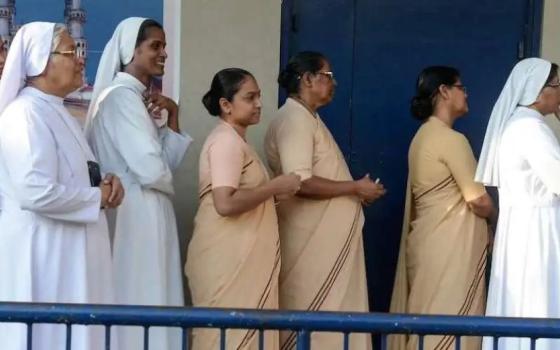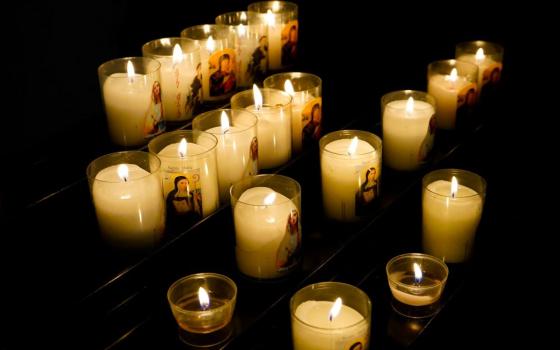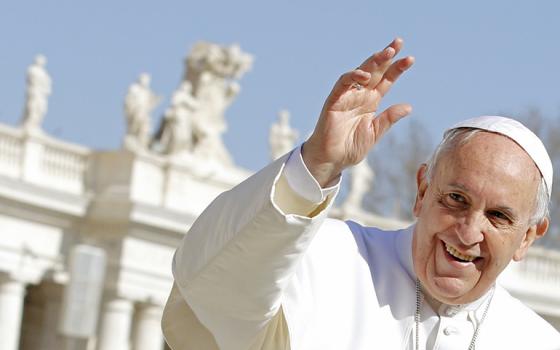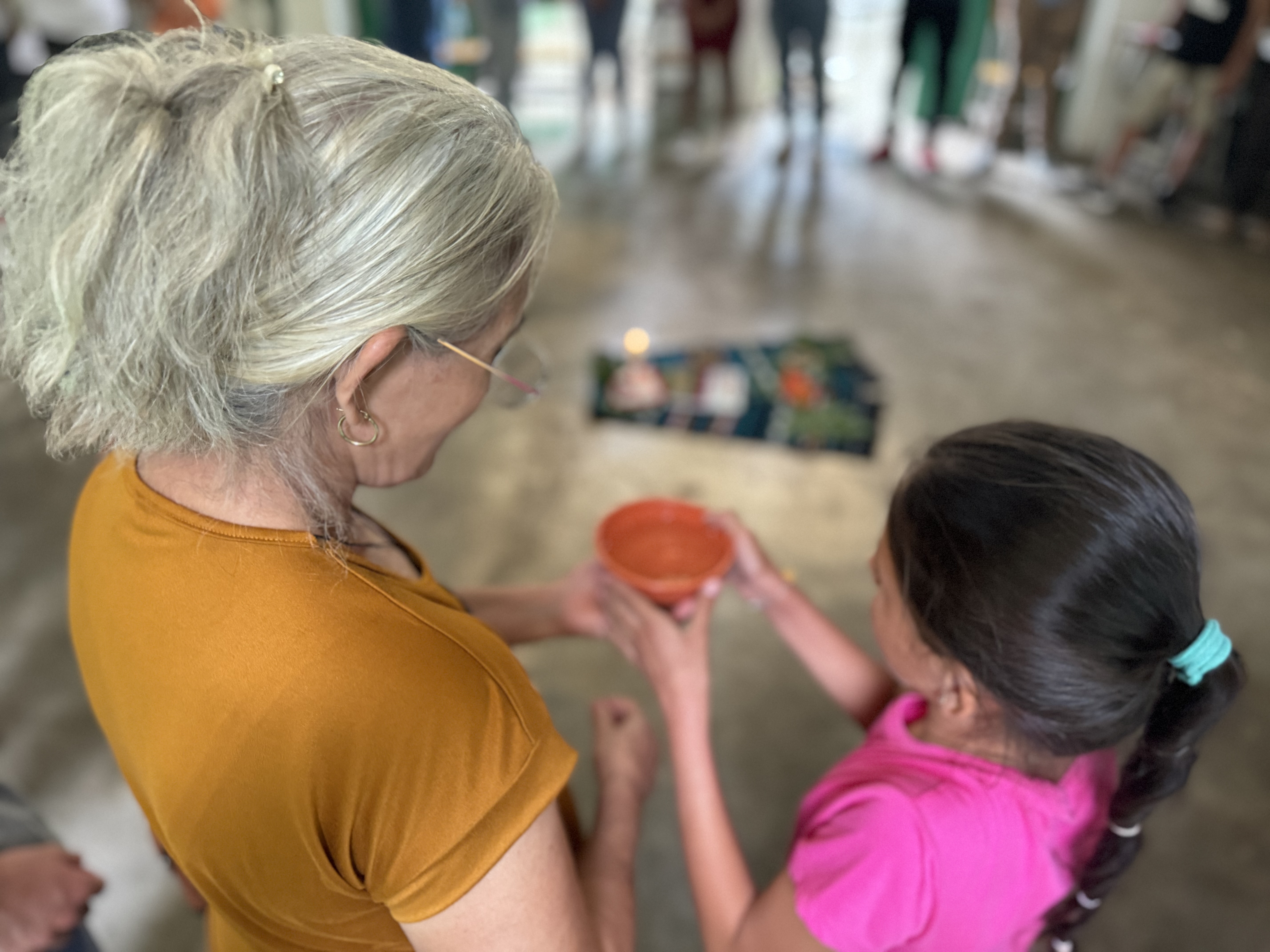
A survivor of a massacre shares water from the Sumpul River with a girl during an intergenerational activity on April 27 in Arcatao, El Salvador, commemorating the killing of more than 600 people in May 1980. (GSR photo/Rhina Guidos)
The mural in the town of Arcatao tells the story of some of the bloodiest hours in the history of El Salvador's armed conflict: children stabbed, peasants riddled with bullets; others trapped in the rising waters of a river stained with the color of blood.
Just as Pablo Picasso's "Guernica" tells the story of the bombing of the town of Gernika (its name in Euskara, or Basque), the mural in Arcatao documents an attack on innocent people on May 14, 1980, in a nearby river called Sumpul.
It was there that military forces killed more than 600 peasants in the northern part of the country. They were ambushed near the river that divides El Salvador and Honduras. Some people, as the mural shows, died after being shot by armed forces; others drowned, their bodies swept away by the current when Honduran soldiers prevented them from crossing.
The mural in Arcatao, in El Salvador, tells the story of the Sumpul River massacre, where more than 600 peasants were murdered by the Salvadoran army on May 14, 1980.

Providence Sr. Vilma Franco sits on a bench in her hometown of Arcatao, El Salvador, April 27, in front of a mural depicting the 1980 massacre on the Sumpul River. Each year, organizations like the Sumpul Association remember the massacre of more than 600 people by armed forces, with a pilgrimage and Mass, an effort to educate and prevent future atrocities. (GSR photo/Rhina Guidos)
Among the cruelest acts, the mural documents how soldiers killed children by inserting bayonets into their small bodies as they fled the horror.
"There have been a lot of massacres here," Providence Sr. Vilma Franco told Global Sisters Report April 27, the day survivors of the Sumpul massacre met with young adults and teenagers in her hometown of Arcatao to learn and talk about what happened 44 years ago.
In the first event of a series organized by groups in the Diocese of Chalatenango, where more than 60 massacres took place during the war, those gathered learned and talked about that difficult past. El Salvador's history books do not tell of such events, despite the fact that the conflict — which started in the 1970s, ending in 1992 — yielded more than 75,000 dead civilians and more than 8,000 disappeared.
"Some people don't know all that took place," said Edith Cruz, a young adult with Caritas Chalatenango's historical memory project and a member of the board of directors of the Sumpul Association, which seeks to educate the region's inhabitants on the massacre's history. "Young people say, 'How did it happen, we didn't see it?' But now, when survivors tell the story, they realize that the events did happen and that it is true," she said.
'It's important for young people to know what we lived through; not to relive the pain. It is a way for them to enter and know the wisdom of the older adults. And for me, since I lived through [the war] as a young person, it's also my responsibility to teach the children [what happened].'
—Sr. Vilma Franco
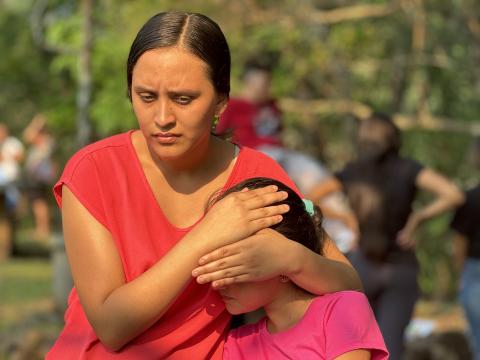
In Arcatao, El Salvador, two young people listen on April 27 to part of the story of May 14, 1980, when armed forces ambushed and then killed more than 600 peasants and their children at the Sumpul River. (GSR photo/Rhina Guidos)
This year, various associations, including Caritas Chalatenango, Sumpul Association, and Association of Communities for the Development of Chalatenango (or CCR) organized intergenerational meetings — prior to the local commemoration of the massacre — to make the region's youth more aware of the past.
At the first meeting in Arcatao, survivors like Felipe Tobar and Julio Rivera participated in small groups with young adults and teenagers in activities aimed at getting to know one another and, little by little, they shared stories in an activity similar to the Stations of the Cross. One station told how some people like Tobar were able to escape. In another station, participants read accounts of survivors who described what they saw; another station told of the river as a source of life and how it was not to blame for what had happened. Tobar taught his group to sing a portion of "La Corrida del Sumpul," a song that narrates the events of that day.
"We are not going to solve the problem by talking about what has already happened, but what we want is to raise awareness among the new generations, with young people, so that they become good young people, who serve the community, who will not lend themselves to violence, because war does not leave behind anything that's good," insisted Tobar. "Those of us who lived through it, we do not want it to happen again. Never. Ever."
Many, including Franco, feel a responsibility to talk about the conflict, considering her father, as well as neighbors, were victims. But there are many in the country who want Salvadorans to stop talking about the past, particularly the war.
Survivors of the Sumpul River massacre, in El Salvador, meet with young people to transmit the historical memory of what happened on the border with Honduras and to prevent similar violence in the future.
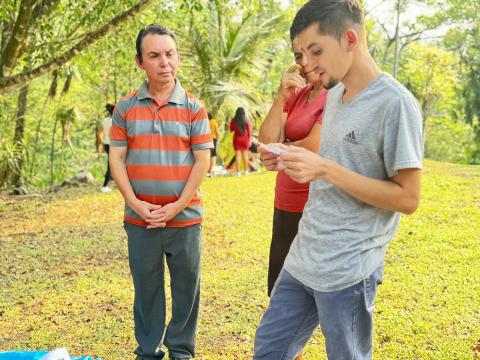
A group of teenagers, accompanied by Julio Rivera, left, a survivor of the Sumpul River massacre, read a story on April 27 in Arcatao, El Salvador, to learn about the ambush and murder of more than 600 peasants in the nearby Sumpul River in 1980. (GSR photo/Rhina Guidos)
In January, the government of El Salvador ordered the destruction of a monument in San Salvador, the country's capital, that commemorated the reconciliation between the two sides involved in the conflict, claiming that the monument was ugly, and denigrated the 1992 agreements that forced the two groups to lay down their arms.
For Tobar, as for Franco, however, history plays an important role in preventing crimes against humanity.
"It's important for young people to know what we lived through; not to relive the pain. It is a way for them to enter and know the wisdom of the older adults. And for me, since I lived through [the war] as a young person, it's also my responsibility to teach the children [what happened]," said the Providence sister.
Franco shared her personal story of serving as a sister in the United States (whose government funded the war in El Salvador), facing certain sentiments but also realizing that many U.S. citizens, many of them Catholics, sent humanitarian aid and were opposed to the conflict, publicly denouncing military aid to El Salvador. She said she saw the difference between the U.S. government, embroiled in Cold War politics, and its citizens, who stood in solidarity with those suffering in El Salvador. Those were lessons that generated a mission in her life: never forget.
"That's why I decided to come here, to El Salvador, to work with my people, from my personal history," she said.
For Tobar, the smiles of the young people, their questions, their interest, sharing, helps him deal with his "sorrows," he said.
As the years go by, there are fewer survivors like him. Organizations such as the Sumpul Association, which now has a majority of young people on its board of directors, has documented many of the testimonies, in writing and on video, and organizes an annual "pilgrimage," which includes a two-hour walk recreating the ambush at the site of the massacre and ending with a Eucharist.
Advertisement
El Salvador's history books do not tell of such events, despite the fact that the conflict — which started in the 1970s, ending in 1992 — yielded more than 75,000 dead civilians and more than 8,000 disappeared.
"Now, our commitment, as young people, is to become the intergenerational 'relay' and accompany" the remaining survivors, Cruz said.
There was a need to do so, she said, not only to let them know about those who died at the Sumpul River, but also to make them aware of so many other injustices.
For Tobar, the opportunity to share the memory of that day is also a "debt" he said that he and other survivors owe to those who died, to tell the truth about what happened to them, even though it is never easy to remember what he saw during those days.
With a bit of sadness, he said that those who survived, now elders, have the privilege of long life denied to those who perished in the massacre.
"I feel privileged to be alive, because it's not easy ... so many people, children who died," he said.

